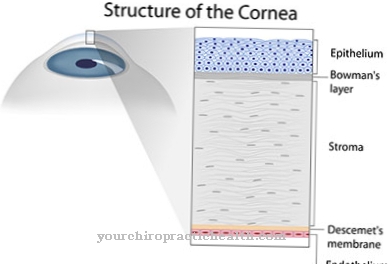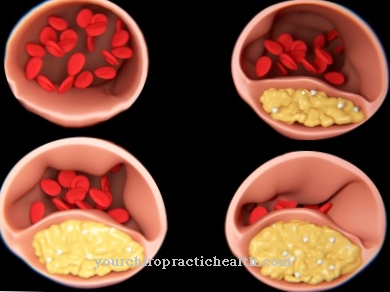A Biliary colic refers to inflammation of the gallbladder caused by stones formed there. Patients suffer from pressure and inflammation pains and often from febrile concomitant diseases, which can result from the body's defense reaction to the internal inflammation of biliary colic.
What is biliary colic?

Biliary colic is usually diagnosed after the occurrence of severe pain in the upper abdomen, which can, however, spread to other parts of the body. It is caused by gallstones that have formed in the gallbladder before the first symptoms appear, which often hinder the natural functioning of the gallbladder after eating a fatty meal to such an extent that it becomes inflamed.
By obstructing this process, in which the gallbladder tries to pump bile into the stomach for digestion and can be blocked by the stones, severe irritation and sudden pain occur.
Stones that have rubbed against each other in the gallbladder for a long time and thus irritated the gallbladder can also trigger biliary colic, which in this case becomes chronic without rapid treatment.
If one of the stones slips into the outlet of the gallbladder and thus blocks the activity of the organ, biliary colic is also triggered. Biliary colic is often accompanied by inflammatory reactions such as chills, fever or, in some cases, even yellowing of the skin.
causes
Biliary colic, which is triggered by gallstones that have formed, can have several causes. Once stones have formed, there is an increased risk of developing biliary colic.
When and why these gallstones form is not exactly known, so in principle anyone can be affected by biliary colic. However, people who eat irregularly and thus prevent regular strain and kneading of the gallbladder seem to be particularly susceptible.
The probability of the formation of gallstones and thus the risk of developing biliary colic increases.
Symptoms, ailments and signs
Biliary colic can be accompanied by sudden, severe [[[upper abdominal pain]], but it can also be slowly announced by a non-specific sensation of pressure and fullness in the upper abdomen. The pain can be felt under the right costal arch or in the middle of the abdomen; it can radiate to the right side to the back and shoulder.
A characteristic of biliary colic is that the pain usually comes and goes in waves, similar to labor pains, which they are also similar in strength. Colic is caused by the contraction of the gallbladder and bile duct to expel the blocking gallstone. The severe pain creates an urge to move in order to relieve the pain.
Exercise is also useful because it can help clear the gallstone. Biliary colic can last anywhere from 15 minutes to several hours. In addition to the severe pain, other symptoms such as gas, bloating, belching, nausea and vomiting can also occur.
Biliary colic can recur as long as there are gallstones in the gallbladder. Sometimes surgical removal of the gallstone or gallbladder will only help in the long term if there are many small gallstones in the gallbladder.
course
Depending on how the biliary colic was first triggered, the symptoms may subside or persist chronically. For example, if eating high-fat food was the trigger, the pain may be reduced once the bile has been completely pumped into the stomach and the gallbladder has stopped contracting.
However, if a patient has been suffering from larger gallstones for a long time, which cause inflammation or blockage of the gallbladder and thus biliary colic through abrasion, the stones must be removed as soon as possible.
Complications
Acute biliary colic can lead to various complications and secondary diseases. First of all, there is a risk that the accumulated bile will escape and get into the abdomen. Such a perforation of the gallbladder can lead to severe inflammation of the internal organs and, in extreme cases, cause life-threatening blood poisoning. The gallbladder itself can become inflamed and cause so-called cholecystitis.
The gallstones rub against each other and cause severe pain in the upper abdomen and sometimes gallbladder empyema. Chronic gallbladder inflammation can promote gallbladder cancer, which is associated with jaundice, unwanted weight loss and the typical symptoms of biliary colic. The treatment of biliary colic can also lead to complications.
The pain relievers and antispasmodics used can cause a number of side effects such as allergic reactions and eye or headaches. In conjunction with other drugs (for example the cancer and rheumatoid drug methotrexate), the prescribed preparations can cause interactions.
Surgical removal of gallstones can cause injuries to the gallbladder. If the gallbladder itself is removed, this can temporarily lead to metabolic disorders, which should, however, subside after a few days to weeks.
When should you go to the doctor?
In the event of sudden severe pain in the chest or stomach area, a doctor should be consulted immediately. It is an acute condition of the body that requires immediate help. If cramp-like symptoms occur in the right half of the body, a doctor is required who must initiate an examination and treatment. The middle and upper abdomen are the regions that attract attention from unexpected attacks of pain and must be examined by a doctor.
If the intestinal activity becomes blocked, medical care is also necessary. If the person concerned suffers from very severe symptoms, an emergency doctor should be called. To prevent further complications, you should remain calm until it occurs. In addition, the instructions of the rescue service must be followed.
If you experience symptoms such as vomiting, diarrhea, chills or nausea, you should consult a doctor. Fever or a general feeling of illness are signs that need to be checked and medically clarified.
In most cases, there is an improvement in health within a few days of receiving medical attention. If this does not happen, a further check-up is necessary. If the biliary pain occurs at repeated intervals, this is considered unusual. It is advisable to work with a gastroenterologist to determine the causes of this.
Doctors & therapists in your area
Treatment & Therapy
There are several options for treating biliary colic, depending on what caused the colic and how big the gallstones are.
Stones smaller than five millimeters can be treated by giving dissolving drugs containing artificial bile acid. If the treatment works, the biliary colic subsides as soon as the stones recede and dissolve.
Stones that have slipped into the connecting conductor to the stomach must be removed as quickly as possible, for which purpose an endoscope is usually used, which is inserted through the stomach. However, this treatment option is only possible if the biliary colic was triggered by a blockage and the stone can be reached by probe.
If the stones are in the gallbladder and they are too big to be resolved by medication, biliary colic can be treated by surgically removing the gallbladder.
This method is also recommended in the case of severe suppuration or infection, as it is assumed here that even if the biliary colic subsides, renewed inflammation must be expected within a few years. The procedure can be performed either through an incision in the abdominal wall, or through a small puncture, the so-called buttonhole method.
Those who do not want to undergo an operation have the option of having larger stones shattered with an external ultrasonic wave treatment and dissolving the fragments with medication and treating the biliary colic in this way.
Outlook & forecast
The prognosis for biliary colic depends on the underlying cause of the symptoms, the size of the gallstones and their location. Basically, the patient has a good prognosis when they seek medical treatment. This worsens once inflammation develops or treatment is refused. In severe cases, the patient is even threatened with a life-threatening condition.
With small gallstones, the symptoms can be alleviated within a few days with medication. The herbs cause the stones to regress and dissolve. Then the patient is considered symptom-free after a few weeks.
Larger gallstones or hard-to-reach foreign bodies are removed in a surgical procedure. This process is associated with the usual risks and side effects. If no complications arise, the patient can also be discharged from treatment after a few weeks as cured.
If there are large stones or gallstones that are located directly in the gallbladder, surgical removal of the gallbladder may be necessary. This intervention is comparatively more extensive and associated with greater consequences. Nevertheless, the prognosis is good here too. As an alternative to an operation, the patient can opt for an ultrasound treatment with subsequent drug therapy. The prospects for recovery are equally good with this treatment plan.
prevention
Those who have acute symptoms of biliary colic can prevent inflammation by eating a low-fat and gentle diet. People with gallstones also often take medication containing bile acid as a preventative measure, which dilute the bile and thus prevent biliary colic.
Aftercare
A regular follow-up check by the doctor is recommended as part of the aftercare. As part of these follow-up checks, the doctor will, among other things, inquire about eating habits and, if necessary, make suggestions for changes. Basically, the diet has to be changed.
A diet that is low in saturated fat and high in polyunsaturated fat is considered ideal. The patient should keep in close contact with a nutritionist during follow-up care and constantly adapt the diet to the symptoms. Aftercare can also include the use of alternative remedies.
Various medicinal plants with a choleretic effect have an antispasmodic effect on the biliary tract and help to improve symptoms. For example, the patient can try peppermint, turmeric, dandelion or wormwood. The use of natural remedies should always be monitored by a doctor so that any side effects can be recognized at an early stage.
Follow-up examinations should take place every three to six months after biliary colic. If there are no further complaints, the distances can be increased gradually. As part of the follow-up checks, blood values are measured and, if necessary, ultrasound examinations are carried out. In addition, the doctor will always take an anamnesis in order to better assess the course of the disease.
You can do that yourself
Biliary colic should always be clarified medically. In most cases, medical treatment can be supported by simple measures and various home remedies.
A change in diet is recommended for regular biliary problems. High-fat or high-sugar foods are common triggers for colic and should be avoided for the time being. It is healthier to eat a balanced diet with fruits, vegetables, whole grains, and lean meat and fish. In general: eat slowly and drink enough water with every meal. Standing up for snacks should be avoided. Dietary measures also help against obesity and high cholesterol levels - both possible causes of biliary colic.
Symptomatic measures can be taken against colic with various medicinal plants. The artichoke reduces gas and bloating, while psyllium, fenugreek, and garlic help relieve stomach cramps. Immediately after eating, acute symptoms can be prevented with herbal teas (made from turmeric, caraway or celandine) and hot abdominal wraps.
If severe symptoms occur despite these measures, you must see a doctor with biliary colic. The symptoms may be caused by a drug or a serious condition that needs immediate treatment.

.jpg)


.jpg)

.jpg)










.jpg)







.jpg)


